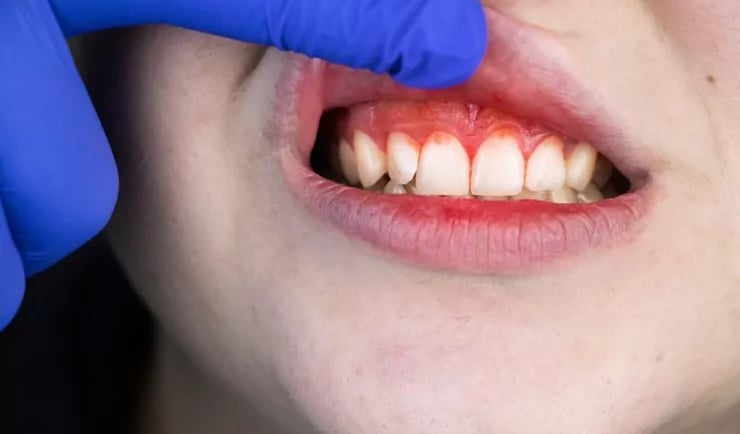SMILE- It costs nothing !!!
Causes of Bleeding Gums in Children & Solutions
Learn about the causes of bleeding gums in children, early signs of gum problems, and effective solutions to safeguard your child's oral health. Prioritize your child's dental care today!
7/31/20253 min read
Bleeding Gums While Brushing in Kids: Causes, Warnings & What Parents Should Do
Are you noticing blood on your child’s toothbrush?
Does your kid complain of sore gums or discomfort while brushing?
Bleeding gums in kids can be alarming — and for good reason. While it’s often brushed off as “normal,” it may be a sign of early gum disease, poor brushing technique, or vitamin deficiencies.
Ignoring bleeding gums during brushing can lead to serious oral health issues, including swollen gums, pain while eating, or even early tooth loss. That’s why understanding the real cause and taking action is crucial.
Let’s explore the reasons, symptoms, and solutions for bleeding gums in children — and how you, as a parent, can protect your child’s smile.
🔍 Why Do Kids’ Gums Bleed While Brushing?
Here are the most common causes of bleeding gums in children:
1. Poor Brushing or Flossing Habits
Many kids either brush too hard or not enough. Aggressive brushing or using a hard-bristled toothbrush can injure the gums, while inadequate brushing lets plaque and bacteria build up, causing inflammation.
The American Dental Association recommends supervising children’s brushing habits to ensure they’re using the correct technique with a soft-bristled brush.
2. Gingivitis (Early Gum Disease)
Even kids can develop gingivitis, especially if oral hygiene is neglected. Symptoms include red, swollen gums, bad breath, and bleeding during brushing.
According to the Mayo Clinic, gingivitis is a mild form of gum disease caused by plaque buildup.
3. Vitamin C Deficiency
Lack of vitamin C (scurvy) can lead to gum bleeding and inflammation. This is more common in picky eaters who avoid fruits and vegetables.
As Healthline explains, vitamin C plays a crucial role in keeping gum tissues healthy and preventing bleeding.
4. Mouth Breathing
Children who sleep with their mouths open often experience dry gums, which can easily bleed and become irritated.
5. Orthodontic Devices (Braces/Retainers)
If your child wears braces or retainers, cleaning around them becomes difficult, increasing the risk of gum inflammation and bleeding.
Related : White spots on kids teeth
🚨 Warning Signs Parents Shouldn’t Ignore
Bleeding gums might just be the first red flag. Here are more signs of gum trouble:
Swollen or reddish gums
Bad breath even after brushing
Complaints of gum pain or sensitivity
Teeth appearing longer due to receding gums
Bleeding while eating crunchy foods
🛠️ What Can Parents Do?
✅ 1. Supervise Brushing
Make sure your child brushes twice a day using a soft-bristled brush and the right technique (gentle circular motion, not scrubbing). Use a brushing timer or app to keep it fun.
✅ 2. Improve Nutrition
Include more vitamin C-rich foods like oranges, strawberries, and broccoli in their diet.
✅ 3. Use a Kid-Friendly Mouthwash
Look for alcohol-free mouthwash that fights bacteria and soothes sensitive gums.
✅ 4. Regular Dental Check-Ups
Take your child for a dental visit every 6 months. The NHS recommends regular dental checkups to detect early signs of gum disease.
✅ 5. Flossing Matters
Teach proper flossing, especially if they have food stuck between teeth, which can irritate gums. If they have braces, consider floss picks or water flossers.
🧑⚕️ When to See a Pediatric Dentist
If bleeding persists for more than a week or is accompanied by pain or swelling, consult a pediatric dentist. It might be a sign of:
Advanced gum infection
Underlying medical conditions (e.g., bleeding disorders)
Tooth eruption issues
Related : Kids Toothache
👨👩👧👦 Tips to Keep Kids' Gums Healthy
Replace toothbrush every 3 months
Avoid sugary snacks and drinks
Use fluoride toothpaste (consult your dentist)
Encourage hydration for saliva production
Make oral care fun with brushing apps, songs, or stickers
Bleeding gums while brushing in kids isn’t “normal.”
It’s a sign that your child’s gums need attention. Early care, balanced nutrition, and regular dental visits can ensure they grow up with strong, healthy teeth and a confident smile.

Contact Smiles
drdeepi15@gmail.com
Dr. Deepika B.D.S
© 2025 SmileWide Dental. All Rights Reserved.
Have doubts ..?


